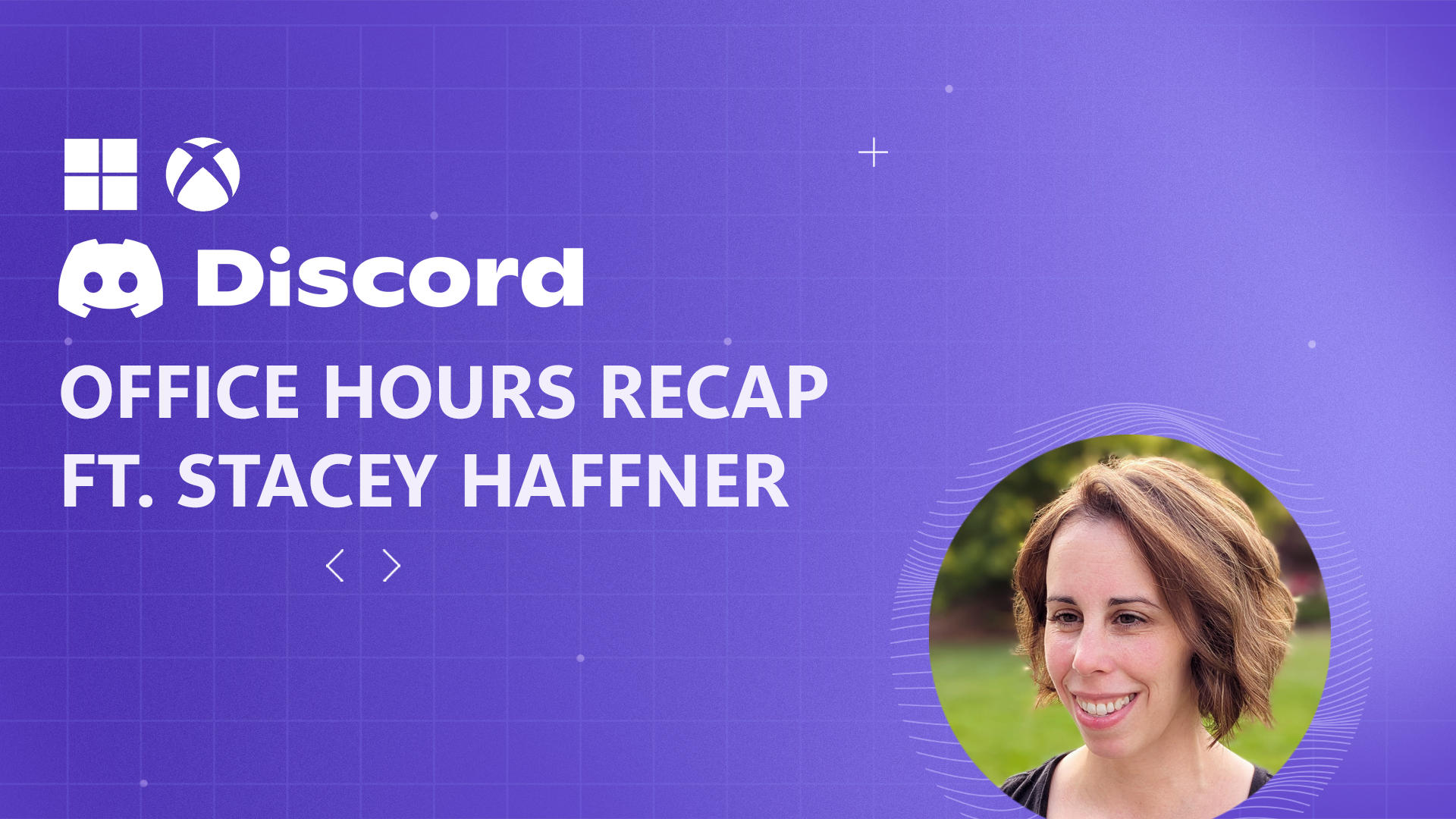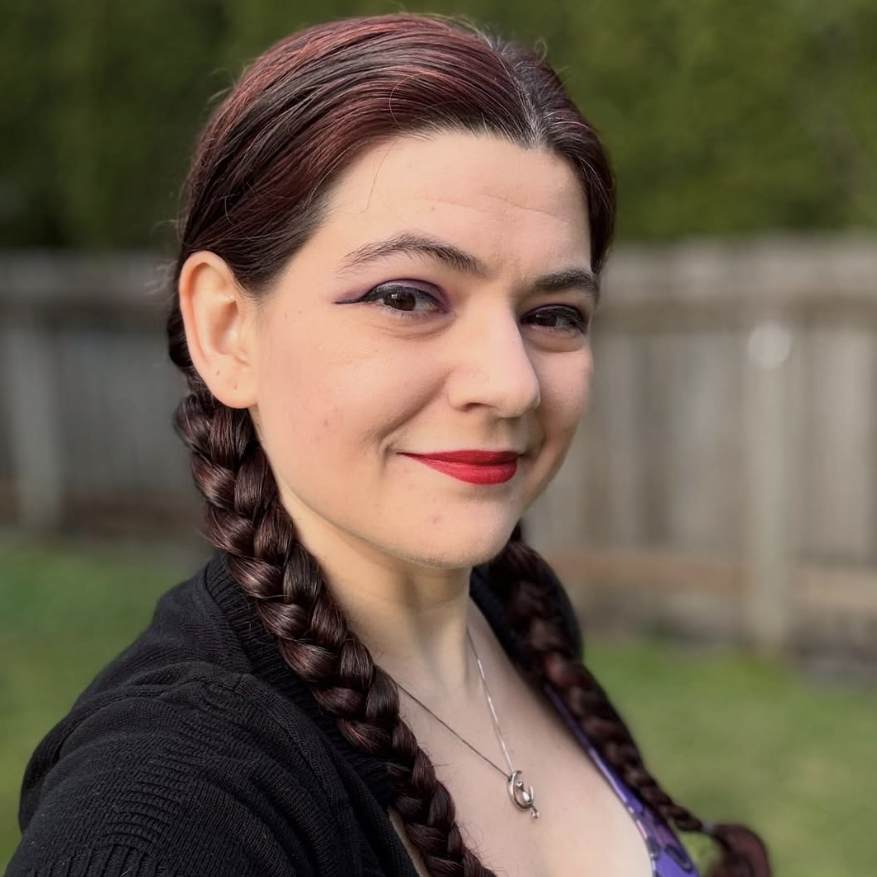Office Hours Recap – Stacey Haffner
In this Office Hours Recap, we spoke to Stacey Haffner, Principal Program Manager and Director of OSPO, about her game development journey at both Microsoft and with her own studio.

Game dev can be hard. There’s a lot to learn, social networks to build, and always new problems to solve. Microsoft wants as many game developers to succeed as possible, and we want to help you on your journey. That’s why, every Friday morning at 11:00 AM Pacific, we invite the game development community to join us on our official Discord for Office Hours.
By creating an open and welcoming community space, one where you can make connections with real industry professionals and ask questions about the issues that are most important to you, we’re making more resources accessible to developers of all sizes from across the globe.
Each week, we invite an experienced game developer to join us, tell their story, and answer any questions you might have about their work. If you’d like to keep up with who will be joining us and what topic we’ll be covering, join our Discord server and keep an eye on the #announcements channel for calendar updates!
On Friday, July 25, we invited Principal Program Manager and Director of OSPO (Open-Source Program Office), Stacey Haffner to join us and share a variety of learnings from her more than 10 years of industry experience. Most recently, she returned to Microsoft after building DevOps and AI Services for game developers as the Director of Product at Unity.
In addition to her current role, Stacey is the CEO and generalist for her very own studio, What Up Games. She also serves on two college advisory boards for their computer science and game design programs and teaches kindergarteners to code robots, making her a perfect source of information on game development from topics on game design to tools and implementation!
The Job(s)
For the past 10 years, Stacey has described her career path as having two different branches: her day job and her “night and weekend job.” Her day job at Microsoft entails running the Open-Source Program Office as well as what she refers to as “game developer advocacy.” This includes the development of projects like an upcoming video series that teaches how to make games using C# and Godot which she’s been teaching herself on top of her existing skills in Unity.
Her nights and weekends are spent running her game studio, What Up Games, with her husband. Over the course of the last ten years, they’ve made various small games, including a multiplayer VR basketball game on the Vive. They’ve been working on their current project, Shatter, for the past four years. Shatter is a PvPvE hero-centric battler where three teams of 30 battle each other over the course of up to seven real-time days. You can learn more and apply to join the alpha on their website.
Q&A
At the end of each Office Hours session, we open the floor for a full Q&A. Below are a few highlights straight from our community and be sure to join us next time if you have a question you want to ask!
About Stacey
Q: How do you balance a day job, game development, and a full family?
A: I don’t sleep! (laughs) What I’ve discovered about myself is that I’m a creator. I find that I have to constantly create something as part of self-maintenance. There’s some stuff with the studio that I’m not great at doing (like marketing, which feels like a slog). But when it comes to making games, it’s a huge passion of mine that doesn’t feel like work.
For years I’ve been teaching my son programming and art concepts. He’s five now, and he’s very intelligent which is wonderful (and sometimes its own challenge). But I’ll involve him in the process. For example, when he was younger I made little prototype games based on his interests and toys that he picked to have me 3D model. He would sit with me and help me choose colors and give me advice on what he wanted to see. Most recently he’s done sketches and sits with me while we 3D model them together. He’s a tester for me, too. I hope, someday, we’ll be making games together! If he doesn’t want to, that’s cool too, but I want him to have the exposure to it.
Q: Is there a particular game that drove you into wanting to make games?
A: My mom will tell you it was Final Fantasy 7. If you’ve played the game, without ruining it for everyone who might not have played it, there’s a moment that brought me to tears. I don’t remember this, but my mom told me when I got to that moment, I looked at her and said “Mom, I’m going to make a game someday.”
The [other] moment I was really reinvigorated on the power of good storytelling, camera work, good everything, was The Last of Us, specifically the intro. It was so well done and absolutely brought me to tears. My mom loves zombies, so I knew I had to get her to play it. I watched her play through [the start of the game], and even though I knew it was coming, it made me cry again. So that’s become the goal now: It’s my life’s mission to make a game that makes people cry. (laughing) I feel like that’s when you’ve hit the peak of storytelling. That level of emotion out of somebody? That’s when you’ve made it.
Unity-Specific Questions
Q: If you were looking for an answer on how to answer a specific question on how to use Unity, where would you go to ask it?
A: I’d give your AI of choice a try first! But if I were looking to ask a human, Unity has their own Discord and Discussion Forums where you can ask your questions. You can sometimes get buried in the Discord as it’s very active, so you may want to try the Discussion Forums first. Stack Overflow can be another great resource to hear from other developers.
General Game Development Questions
Q: Do you have to have a team to make a game studio?
A: No, you don’t! However, the whole reason we started a studio was for legal protection. The studio is our legal entity to protect our assets and retain IP control.
Q: When developing a game, when is it time to swap from building systems to building world and lore?
A: I do both at the same time. My husband will tease me about building too much infrastructure too soon and heavily encourages me to focus on a “vertical slice”, So, the habit now with an RPG I’m prototyping is to focus on “good enough” infrastructure so that I can build out different systems that I need, when I need them. For this game I started with the basics like which systems I want, which was centered around what combat will look like. Then I’ll bounce off that and start to think through classes, attributes, abilities, and lay out what I want there. It is all connected so I’ll come back to the basic systems afterward and start refining them. Bouncing around helps me stay interested in the projects I’m working on. That just happens to be how my brain works; a different approach might work better for you than it does for me.
Q: Do you need the world to blend into the systems, or do you build the world around what systems you have?
A: What we have found is that it depends on what you’re building and what interests you. 9 out of 10 times our games focus on mechanics and then we retro fit the world. But with my roleplaying game, my world started being formed as early as the movement mechanics. Because I want time travel to be involved, I constantly have to ask questions like “what type of puzzles does this serve” or “how does movement work with these abilities?”
I’m mechanically driven, so that’s almost always going to be where I start. But you might be more narratively driven and want to build your world first and have your systems serve it.
Q: What is a vertical slice?
A: You probably hear the phrase “Find the Fun” a lot in game development, that’s the most common one which is usually centered around the core game play loop. When you think about a vertical slice, your goal is to complete a small portion of your vision that proves something. Vertical slices are hypothesis driven; you come up with your theory about what you want to test, then you create just enough of the game to do it. You learn, then you iterate.
What you build might need to demonstrate the gameplay, the environment, and/or the story all at once without being a fully finished product.
Q: Do you remake mechanics/features/code or do you borrow from old/other projects?
A: I would say 99% of the time I remake it. Usually because I’m a much better developer now than I was originally. A lot of times I’m cursing Past Stacey and the code that I wrote.
In all seriousness, we tried to do this with a UI system and an Input system because we were tired of making them over and over again. We ultimately ended up never using it for UI and eventually Unity released a new input system that killed the need for the custom logic that we had built. That was the only time we tried to be thoughtful on reusable systems across games.
When it comes to more game-specific things like mechanics, features, or infrastructure, it usually ends up getting rewritten. Either what we wrote before doesn’t work for the new game, or we just didn’t know what we were doing early on in our first games! We’ve learned so much over ten years.
Q: Is there any game right now you’re really looking forward to that hasn’t come out yet?
A: The Outer Worlds 2. I’ve told my husband “don’t expect to see me for a month” when that game comes out. I played the first one during my last month of pregnancy and binged the whole thing.
I watched the recent Xbox showcases on it. The perks, the humor in that game… I can’t wait for that to come out!

